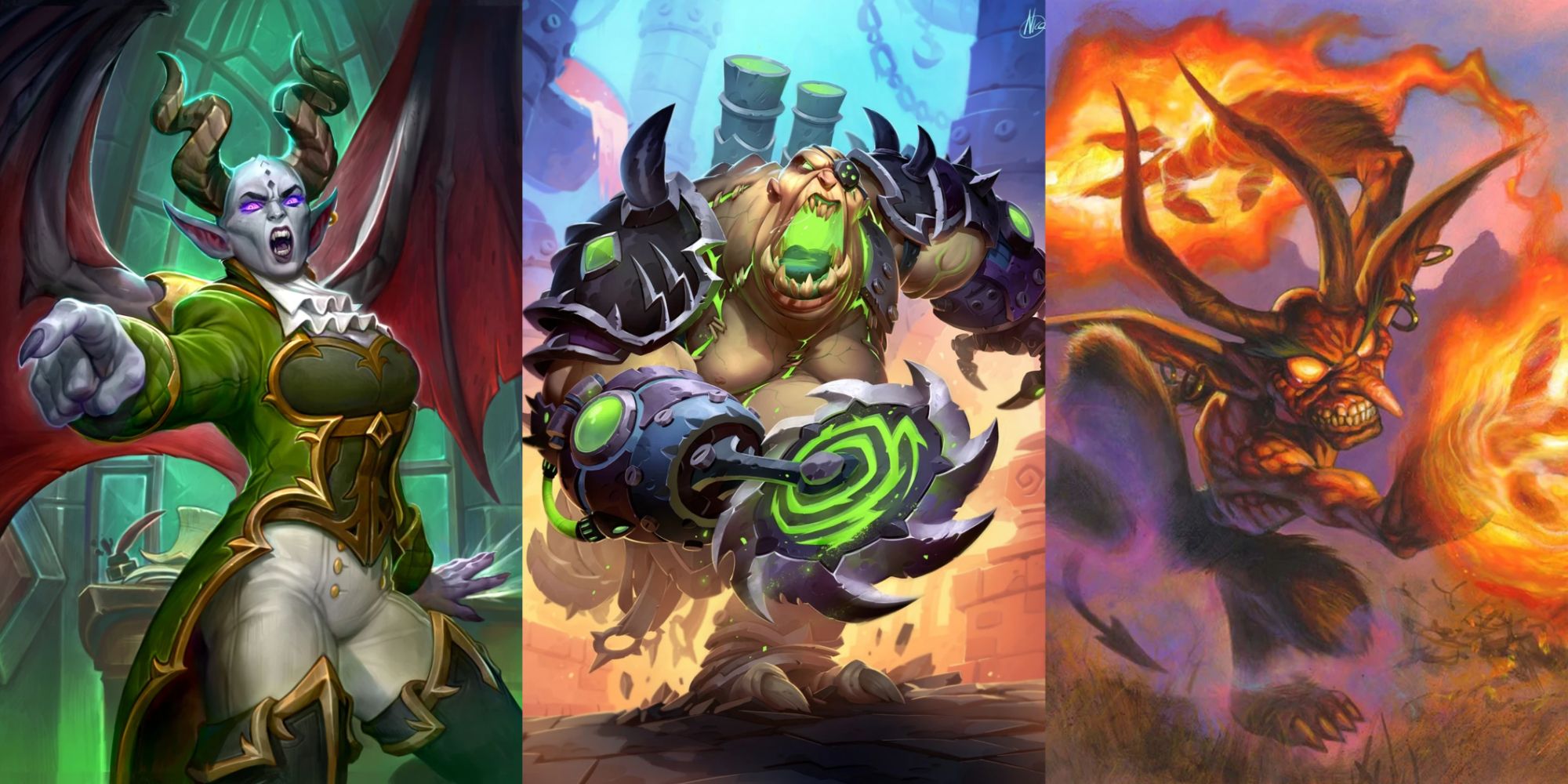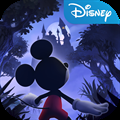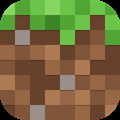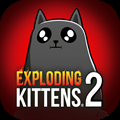
Demons are one of Hearthstone’s most iconic minion types. They’ve always been fixtures in Warlock decks, from the Zoo Warlocks of Classic Hearthstone to the Imp Warlock decks of today’s Standard meta, and they have only increased in prominence since the introduction of Demon Hunter as a class.
Related: Hearthstone: The Best Demon Hunter Cards
Demons come in all shapes and sizes, ranging from small-but-irritating Imps to massive, game-ending monstrosities. And they vary just as much in their power level as they do in their appearance. To help you decide which of them are worth your dust, here are the best Demons you can play in Standard right now.
10 Bloodbound Imp
Let’s get this out of the way: the main reason Bloodbound Imp sees play is the existence of Imp King Rafaam. The Imp King needs Imps to resummon with his Battlecry, and the Bloodbound Imp is one of your best options. It’s not hard to see why that is the case; five health on a three-mana minion is a lot.
In the right situation, the Bloodbound Imp can clean up multiple low-cost minions your opponent plays before dying. The self-damage effect could potentially be a problem, but for board-centric decks, taking some minor chip damage from the Bloodbound Imp usually isn’t going to matter. Besides, as all good Warlock players know, your life total only matters once it hits zero.
9 Mo’arg Forgefiend
The Mo’arg Forgefiend is a common inclusion in decks that need a big, defensive option, usually intending to either cheat it out early or to summon it over and over again (sometimes both). This sort of tricky behavior is necessary because the Forgefiend is quite slow at eight mana, since it doesn’t do anything immediately when played.
However, it can present real problems for aggressive decks, especially when played earlier than intended, since it effectively heals you for 16 life thanks to the combination of Taunt and armor gain. Against control decks, it’s still an 8/8 they need to deal with.
8 Battlefiend
Ever since the Hearthstone team nerfed the Battlefiend, reducing its base attack by one, it is no longer completely oppressive when played in the early stages of the game. However, it is still a constantly scaling threat, making it one of the few one-drops that need to be answered quickly.
Related: Hearthstone: The Best Druid Cards
It’s not currently run in the most popular variant of Aggro Demon Hunter, but some variants do find a way to slot it in. Whenever building an aggressive deck with the class, the Battlefiend will always merit consideration.
7 Imp Gang Boss
The Imp Gang Boss used to be strong because of its stats, which allowed it to get value trades and consistently summon additional bodies. Minion stats have steadily increased over Hearthstone’s lifetime, making those value trades harder to come by, but the recent introduction of the Infuse mechanic has given this card new life. Cards that create multiple minions are better than ever.
And, of course, one Infuse card in particular, Imp King Rafaam, has made summoning Imps an especially good idea. Thanks to him, the Imp Gang Boss is relevant again for the first time since it returned to Standard with the Core Set.
6 Voidwalker
The Voildwalker doesn’t exactly seem like top-ten list material at first glance. A 1/3 with Taunt is hardly an aggro powerhouse, nor will it stall your enemies for long. But even in modern Hearthstone, 2/1 and 1/2 minions are relatively common, and the Voidwalker eats them for breakfast. Meanwhile, minions that can kill it and survive are extremely rare on turn one.
And the fact that the Voidwalker has Taunt means your opponent will either need to take those unfavorable trades or not attack at all. It probably won’t be your first choice, but if your Warlock deck needs a one-drop, the humble Voidwalker is always there for you.
5 Brutal Annihilan
The Brutal Annihilan will appear in March of the Lich King, and the deck it would most likely fit into, Big Demon Hunter, isn’t exactly dominating the meta at the moment. But one thing that archetype really needed was more powerful Demons in its arsenal, and the Brutal Annihilan could be the perfect fit.
The dual keywords of Taunt and Rush allow it to simultaneously be defensive and proactive, while its special ability lets you put pressure on your opponent’s life total. And the fact that it can do all of those things at once makes it strong in basically every matchup. It’s too early to say whether or not Big Demon Hunter will be a viable strategy in the upcoming meta. But the Brutal Annihilan is a strong step in the right direction for the archetype.
4 Prosecutor Mel’tranix
Prosecutor Mel’tranix is a potent hand disruption tool. Thanks to their low-cost cards, aggro decks will generally be able to play around her ability, making Mel’tranix a minor nuisance at best. But against control decks, you can actually lock them out of most of their options, protecting you from board clears and stalling the development of their game plan. And Mel’tranix can cause even bigger problems for combo decks if you can time her ability to coincide with when they want to trigger their combo.
Meltranix’s effect won’t always work out; sometimes your opponent’s best move will align perfectly with the cards Mel’tranix allows them to play. However, she will almost always put them in a moderately troublesome situation and has the potential to do far more than that.
3 Flame Imp
Once upon a time, playing a Flame Imp on turn one could be a game-winning move, dominating the board and putting pressure on your opponent for the low cost of three life. The general power level of Hearthstone cards has gotten much higher since then, but the Flame Imp is still strong enough to challenge just about any other one-cost minion.
Related: Hearthstone: The Best Rogue Cards
As a result, it has been played in pretty much every Warlock deck looking to contest the board in the early game since the earliest days of competitive Hearthstone, and it doesn’t look like that will change any time soon.
2 Mischievous Imp
The many versions of Imp Warlock on the Standard ladder run a wide variety of Demons, including several that appeared earlier on this list. But Mischievous Imp is one of the cards that really make the deck work.
Its Infuse cost of three isn’t especially difficult to trigger by turn four, and three 3/3 bodies is a lot of power at any stage in the game, especially so early. It also provides bodies for your Imp King Rafaam’s own Infuse cost, and they can be resummoned by his effect. It’s hard to imagine a card that fits the deck better (other than the King himself).
1 Xhilag Of The Abyss
Xhilag of the Abyss is one of the Colossal minions introduced in the Voyage to the Sunken City expansion, and it lives up to the name. When played, it summons four Stalks that will fire random beams of damage at your opponent and their minions at the end of your turn.
Most of the time, a significant number of the minions created when you play Xhilag won’t survive your opponent’s turn.
But at that point, Xhilag has already dealt eight damage and forced an answer from your opponent. And that’s in the worst-case scenario. If your opponent doesn’t have a way to kill the Stalks, they will continue to deal damage even if Xhilag itself doesn’t survive (although they won’t gain any more damage). And if they can’t clear any parts of Xhilag, they’re probably just dead.
Next: Hearthstone: The Best Legendary Cards For Standard













